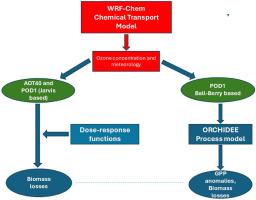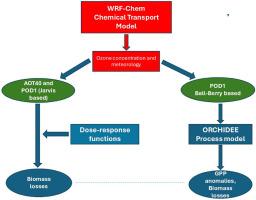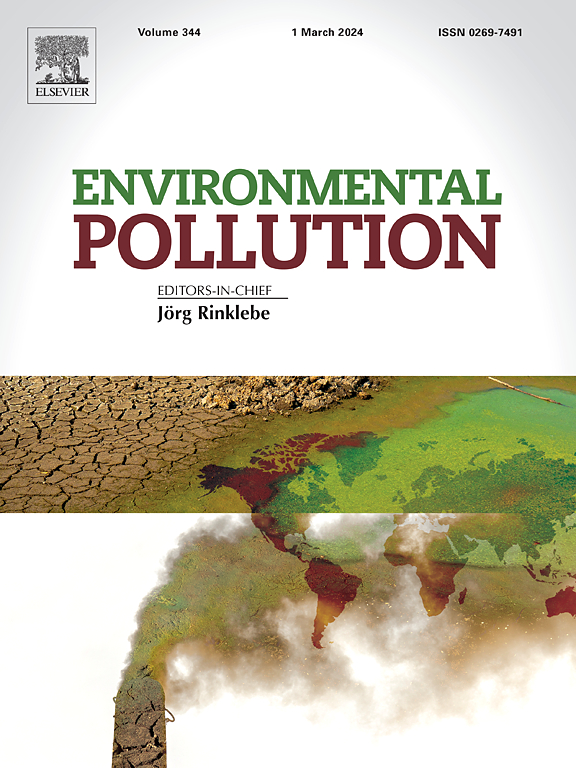Inconsistency between process-based model and dose-response function in estimating biomass losses in Northern Hemisphere due to elevated O3
IF 7.3
2区 环境科学与生态学
Q1 ENVIRONMENTAL SCIENCES
引用次数: 0
Abstract
Tropospheric ozone (O3) concentrations in the Northern Hemisphere have significantly increased since the pre-industrial era, with ongoing growth driven by emissions from industrial, agricultural, and transportation activities, further exacerbated by the warming temperatures and altered atmospheric circulation patterns associated with climate change. This study compared different methodologies for estimating biomass potential losses (BPL) in forests due to elevated O3 using both concentration-based (AOT40) and flux-based (POD1) metrics. Moreover, to further assess the impact of O3 on forest health and carbon uptake across the dominant forest types in the Northern Hemisphere, we also compared BPL estimates from dose-response functions with those derived from the process-based model ORCHIDEE.
Our analysis showed that deciduous forests, particularly boreal and continental types, are more sensitive to O3-induced biomass loss compared to evergreen forests. Importantly, the study also revealed significant regional differences, with Europe and North America experiencing higher BPL than Asia and North Africa. Regression analysis between BPL and Gross Primary Production anomalies indicated that the relationship between O3 exposure and forest productivity varied across forest types, with continental deciduous forests showing stronger correlations. The findings highlighted the importance of using flux-based metrics like POD1 in assessing O3 impacts and that current dose-response functions may require further validation across diverse ecological settings to propose effective forest management and conservation strategies.


基于过程的模型与剂量反应函数在估算臭氧升高导致北半球生物量损失时的不一致性
自前工业化时代以来,北半球对流层臭氧(O3)浓度显著增加,工业、农业和运输活动的排放推动了臭氧浓度的持续增长,而与气候变化相关的气温升高和大气环流模式改变进一步加剧了臭氧浓度的增长。本研究采用基于浓度(AOT40)和基于通量(POD1)的指标,比较了估算臭氧升高导致的森林生物量潜在损失(BPL)的不同方法。此外,为了进一步评估 O3 对北半球主要森林类型的森林健康和碳吸收的影响,我们还比较了剂量反应函数和基于过程的 ORCHIDEE 模型得出的 BPL 估计值。我们的分析表明,与常绿森林相比,落叶林(尤其是北方和大陆类型)对 O3 引起的生物量损失更为敏感。重要的是,研究还发现了显著的地区差异,欧洲和北美洲的生物量损失率高于亚洲和北非。BPL 与总初级生产力异常之间的回归分析表明,不同类型森林的臭氧暴露与森林生产力之间的关系各不相同,大陆落叶林的相关性更强。研究结果强调了使用基于通量的指标(如 POD1)评估臭氧影响的重要性,并指出目前的剂量-反应函数可能需要在不同的生态环境中进一步验证,以提出有效的森林管理和保护策略。
本文章由计算机程序翻译,如有差异,请以英文原文为准。
求助全文
约1分钟内获得全文
求助全文
来源期刊

Environmental Pollution
环境科学-环境科学
CiteScore
16.00
自引率
6.70%
发文量
2082
审稿时长
2.9 months
期刊介绍:
Environmental Pollution is an international peer-reviewed journal that publishes high-quality research papers and review articles covering all aspects of environmental pollution and its impacts on ecosystems and human health.
Subject areas include, but are not limited to:
• Sources and occurrences of pollutants that are clearly defined and measured in environmental compartments, food and food-related items, and human bodies;
• Interlinks between contaminant exposure and biological, ecological, and human health effects, including those of climate change;
• Contaminants of emerging concerns (including but not limited to antibiotic resistant microorganisms or genes, microplastics/nanoplastics, electronic wastes, light, and noise) and/or their biological, ecological, or human health effects;
• Laboratory and field studies on the remediation/mitigation of environmental pollution via new techniques and with clear links to biological, ecological, or human health effects;
• Modeling of pollution processes, patterns, or trends that is of clear environmental and/or human health interest;
• New techniques that measure and examine environmental occurrences, transport, behavior, and effects of pollutants within the environment or the laboratory, provided that they can be clearly used to address problems within regional or global environmental compartments.
 求助内容:
求助内容: 应助结果提醒方式:
应助结果提醒方式:


